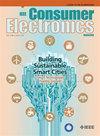信号交叉口部分无线充电车道生态驾驶:一种强化学习方法
IF 4.3
2区 计算机科学
Q1 ENGINEERING, ELECTRICAL & ELECTRONIC
引用次数: 0
摘要
先进的全球定位系统(GPS)、车辆传感器、惯性测量单元(IMU)和无线模块等消费电子产品将车对车(V2V)和车对基础设施(V2I)集成到物联网(IoT)中,使联网自动驾驶电动汽车(CAEV)能够通过生态驾驶实现能源优化。在有红绿灯路口和部分无线充电车道(WCL)的场景中,生态驾驶算法必须考虑净能耗和总能耗、安全性和交通效率。我们引入了一种基于深度强化学习(DRL)的生态驾驶控制方法,采用双延迟深度确定性策略梯度(TD3)代理进行实时加速规划。该方法使用加速、速度、安全和效率奖励函数,结合动态速度范围模型,不仅能使车辆顺利通过信号灯控制的交叉路口,还能在不同交通场景中高效、适时地使用部分 WCL,同时确保交通效率。通过在模拟城市交通(SUMO)中使用部分 WCL 通过各种交叉路口的测试,与传统驾驶相比,我们的方法显著降低了净能耗和总能耗,降幅分别高达 44.01% 和 17.19%,同时遵守了交通和安全规范。本文章由计算机程序翻译,如有差异,请以英文原文为准。
Eco-Driving With Partial Wireless Charging Lane at Signalized Intersection: A Reinforcement Learning Approach
Consumer electronics such as advanced GPS, vehicular sensors, inertial measurement units (IMUs), and wireless modules integrate vehicle-to-vehicle (V2V) and vehicle-to-infrastructure (V2I) within Internet of Things (IoT), enabling connected autonomous electric vehicles (CAEVs) to optimize energy optimization through eco-driving. In scenarios with traffic light intersections and partial wireless charging lanes (WCL), an eco-driving algorithm must consider net and gross energy consumption, safety, and traffic efficiency. We introduced a deep reinforcement learning (DRL) based eco-driving control approach, employing a twin-delayed deep deterministic policy gradient (TD3) agent for real-time acceleration planning. This approach uses reward functions for acceleration, velocity, safety, and efficiency, incorporating a dynamic velocity range model which not only enables the vehicle to smoothly pass the signalized intersections but also uses partial WCL efficiently and time-adaptively while ensuring traffic efficiency in diverse traffic scenarios. Tested in Simulation of Urban Mobility (SUMO) across various intersections with partial WCL, our method significantly lowered net and gross energy consumption by up to 44.01% and 17.19%, respectively, compared to conventional driving, while adhering to traffic and safety norms.
求助全文
通过发布文献求助,成功后即可免费获取论文全文。
去求助
来源期刊
CiteScore
7.70
自引率
9.30%
发文量
59
审稿时长
3.3 months
期刊介绍:
The main focus for the IEEE Transactions on Consumer Electronics is the engineering and research aspects of the theory, design, construction, manufacture or end use of mass market electronics, systems, software and services for consumers.

 求助内容:
求助内容: 应助结果提醒方式:
应助结果提醒方式:


